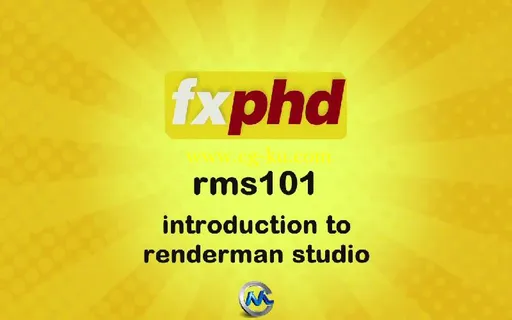本视频教程是由FXPHD机构出品的Renderman渲染器高级视频教程,FXPHD RMS101 Introduction to Renderman Studio,大小:1.88 GB,MP4高清视频格式,教程使用软件:Renderman Studio 3.0,作者:Manuel Kraemer,官方发布日期:2011年4月,语言:英语。CG数据库整理。
RenderMan是一个计算机图像渲染体系,准确地说是一套基于著名的REYES渲染引擎开发的计算机图像渲染规范,所有符合这个规范的渲染器都称为RenderMan兼容渲染器。这其中最著名的有3delight和 Pixar公司的Photorealistic RenderMan,同时在业界还有一些其它的免费版开源的RenderMan兼容渲染器。
RenderMan兼容渲染器其高超的渲染质量和及其快速的渲染能力而被广泛应用在高端运动图像的生产制作过程中,在当今的动画电影和影视特效等高端领域,RenderMan兼容渲染器是必不可少的一个渲染解决方案(另一个高端解决方案是著名的Mental Ray渲染器),世界上许多著名制作公司像ILM和Sony等都使用它作为作为渲染的最终解决方案之一。
目前最普及的RENDERMAN 是3DELIHGT 因为3DEIHGT的开放性和用户口群的庞大,3DELIHGT 已经成为RENDEMAN 电影级别渲染器的主流。其制作的电影有:《神奇四侠》,《第九区》,《死神来了》,《哈利·波特》,《绿巨人》,《终结者》,《超人归来》,《X战警》等。
FXPHD机构是老牌在线教学网站,网站的创建者就是Fxguide的团队,PXPHD制作了大量视觉特效、后期制作、摄影摄像的精品教程。每年支付4000元左右,就可以享受其中5门课程的教学,还可以提供VPN链接内网,每套课程都是10周左右的时间,每节课30分钟左右,包含训练文件和素材。FXPHD主打专业教学,所有的教程作者都是该领域的权威,必须拥有大量的项目经验。
FXPHD RMS101 Introduction to Renderman Studio
Pixar’s Renderman@ is a core rendering technology that has been powering production pipelines since 1985. Leading digital effects houses and computer graphics specialists use Pixar’s RenderMan@ because it is the highest quality renderer available anywhere and has been production tested through successful use in feature films for over ten years. RenderMan’s powerful features such as programmable shading language and anti-aliased motion blur allow designers to believably integrate stunning synthetic effects with live-action footage. RenderMan is used for Pixar’s own feature film productions.
The RMS 101 series of classes is aimed at the beginner user wishing to discover how to enhance a small to medium sized production pipeline with Pixar’s professional suite of integrated shading and rendering tools. RMS101 will introduce all the different components of the suite, such as Alfred, Slim and show how these workflows integrate with Renderman Pro Server. The class is structured around a progression of small projects, each uncovering new features and workflows of the Renderman Studio Pro suite, always focusing on practical applications for shading, lighting and rendering.
Manuel Kraemer is currently a software engineering technical director in the Production Engineering group at Pixar Animation Studios. He received a M.Sc. in Computer Science at the University of Teesside (UK) in 1996. In London, he contributed to projects such as the BBC Science documentary “The Planets” and Universal’s sci-fi thriller “Pitch Black”. In 2000 he relocated to the US at the Walt Disney Company, working on the stereoscopic ride “The Magic Lamp” and then moving on to the research project “Gemini Man, exploring photorealistic facial capture and rendering technologies. He started at Pixar Animation Studios in 2002, developing the skin rendering software for the Oscar winning “Incredibles” movie and contributing to the shading and rendering technologies of titles such as “Cars”, “Ratatouille”, “Wall-e” and “Up”.
详细章节内容:
class syllabus:
Class 1: Installing & configuring the software
Class 2: How Maya shading interfaces with RMS, an exploration of the RMS render controls panel and highlighting the differences between Maya’s and RMS’s rendering systems.
Class 3: Technical aspects of modeling. Looking at the different ways to create smooth shapes out of subdivided meshes and how this relates to shading with RMS.
Class 4: Say hello to Slim. Covering the interface and the basic mechanisms of Slim.
Class 5: Introducing the Slim node: AllPurpose, a rendering system that is able to accurately represent most physical materials.
Class 6: Working further on the look development of materials and illumination. Using procedural methods to age and weather materials with the help of composited layers.
Class 7: Exploring light transmission: specular transmission with glass and diffuse transition with milk.
Class 8: Continuing a look into light transmission with discussion of sub surface scattering.
Class 9: Introducing PTex: a new file format standard dedicated to three dimensional texture images.
Class 10: How to use RMS and Slim to bind PTex textures to the geometry through the shader.



发布日期: 2012-11-1